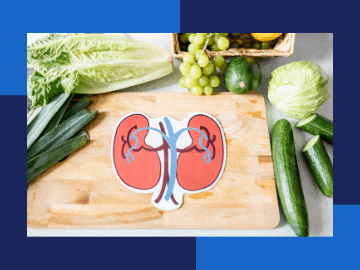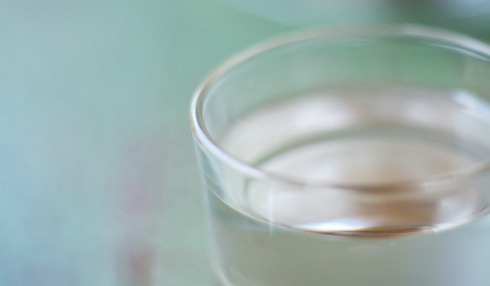What are kidney stones?
Approximately 1.7 million Australians aged 18 years and over have indicators of chronic kidney disease, such as reduced kidney function or the presence of albumin in the urine.— Australian Bureau of Statistics
Kidney stone disease is one of the most common disorders of the urinary system. There are four types of kidney stones or renal calculi: calcium oxalate, uric acid, struvite and cystine. These stones when not treated or managed accordingly, may block the flow of urine and cause infection, kidney damage or worse, kidney failure that may result to premature death.
If you feel that you might be experiencing signs of kidney stone disease, consult a medical practitioner immediately. This way, you can be assessed by your doctor and find the appropriate treatment plan for your condition.
If you have been diagnosed with urinary stone disease then you probably already know that stone attacks cause severe and distressing pain. This page aims to answer some of the questions you may have about your stone, on this page you can learn about the following:
- Kidney stones prevention and treatment
- Tips for kidney stones prevention
- Types of kidney stones
- Kidney stones, removal treatments and options
- Frequently asked questions
- Statistics
Preventing and treating kidney stones
There are various treatment methods to remove stones formed in the kidney. These include an endoscopic procedure, percutaneous nephrolithotomy, open surgery, lithotripsy and extracorporeal shockwave lithotripsy (ESWL).
Anyone who has had kidney stone disease can prevent its recurrence by making lifestyle changes and using medications.
Kidney stone symptoms
What are kidney stone symptoms?
- Renal colic – severe gripping pain in the back just below the ribcage.
- Pain in the back that also radiates around to the front and towards the groin.
- Pain during urination.
- Nausea and vomiting as a result of severe pain.
- Difficulty passing urine due to a large stone blocking the flow.
- The unusual appearance of urine – for example, it may be pink or brown in colour (which may indicate the presence of blood) and/or have a foul odour.
- Infection accompanied by fever and chills.
- A feeling of needing to urinate more often than usual.
- Small gravelly stones passing in the urine.
Is it serious?
Aside from being acutely painful, urinary stones can be serious if they cause obstruction of the urinary tract or are associated with urinary tract infection. In fact, urinary stones can often present a medical and surgical emergency, but they’re very treatable. As long as you are treated promptly by an experienced urologist, urinary stones are rarely life-threatening and are usually not a cause of ongoing concern with proper management.
Tips for preventing kidney stones:
If you have had a urinary stone, these are some preventative measures that you can do to minimise its onset and stop its recurrence.
- Drink adequate amounts of water throughout the day: Doctors recommend drinking 2 to 3 litres of water a day to prevent your urine becoming concentrated. The colour of the urine should be light and clear like water: “if it’s white, it’s right!”
- Reduce the sodium in your diet. High sodium in your diet may increase the amount of calcium in your urine, resulting to the formation of kidney stones. To prevent the formation make sure to reduce your daily sodium intake. Doctors suggest limiting your total sodium intake to 1,500 mg on a daily basis.
- Limit eating animal protein and oxalate-rich food. Eating red meat, seafood, eggs and poultry may boost the level of uric acid in your urine, leading to the formation of uric acid stones. Also, limit your intake of oxalate-rich food, such as nuts, beets, okra, spinach, tea, sweet potatoes, chocolate and soy products because these may induce the formation of calcium oxalate stones.
- Visit your doctor for a regular check-up. If you have been tested, ask your doctor to check you for any metabolic causes of stone formation: this involves a routine blood test to assess calcium and uric acid levels.
- Follow the medical advice you are given. To stop the recurrence of this disease, make sure to follow the medical advice given to you by your physician. Depending on what kind of stone you have, additional treatment may be recommended.
Preventing kidney stones simply means preventing the conditions that support its formation. So make sure to follow these simple tips to help prevent its recurrence.
Here are some more great resources on preventing kidney stones.
What are the different types of kidney stones and how are they different?
Calcium oxalate stones:
The great majority of urinary stones (95%) treated in Australia are composed of calcium oxalate. Because they contain calcium, like your bones, these stones are visible on plain X-rays. High calcium levels or hypercalcaemia may contribute to calcium oxalate stone formation. Hypercalcaemia has a number of treatable underlying causes – if you have high calcium, further investigations will be undertaken. Most calcium oxalate stones form in the absence of hypercalcaemia. Excess dietary salt may increase the risk of stone formation as it increases calcium in the urine and decreases the action of inhibitors of stone crystallisation.
Uric acid stones:
Around 5% of urinary stones are comprised of uric acid, produced as a by-product of purine metabolism. Purines are found in certain foods, including red wine, beer and red meat. If you suffer from uric acid stones, your doctor may recommend limiting your dietary intake of purine containing foods. Uric acid stones tend to form in acidic urine, so treatments to reduce the acidity (or alkalinise) your urine may also be recommended, usually, this involves taking sodium bicarbonate in solution.
Cystine stones:
Cystine stones are rare but may occur in people with high levels of cysteine (an amino acid) in the urine.
The exact chemistry of stone formation is complex and not fully understood. Certain conditions increase the probability of stone formation: dehydration (by producing concentrated urine), conditions which interrupt the flow of urine from the kidneys or bladder, recurrent urinary tract infections, certain metabolic abnormalities and/or excess salt in the diet.
Struvite or infective stones:
Bacteria can reduce the acidity of the urine, predisposing to precipitation of stones formed from calcium, magnesium and phosphate. Women, in particular, are prone to infective stones.
All stones have the potential to cause an obstruction in the urinary tract, so surgical treatments are necessary.
What kind of kidney stones tests will I have when I am diagnosed?
You will have a CT scan and a plain X-ray, you may also have an ultrasound.
You will have a blood test to measure calcium and uric acid levels; if these are abnormal you may need to follow up blood tests.
Treatment options for the removal of kidney stones
Treating a kidney stone depends on your stone: where it is and what effect it is having on your urinary tract. You may require nothing but pain management or you may require a surgical procedure. There are several different procedures performed for the removal of kidney stones:
- Endoscopic procedures (ureteroscopy)
- Extracorporeal shockwave lithotripsy (ESWL)
- Percutaneous nephrolithotomy
- Open stone surgery
Endoscopic Procedures
These procedures require no incisions: they involve passing a tube with a small camera on the end, called a ureteroscope, through the ureter or kidney to the site of the stone.
To relieve obstruction and pain, a stent is placed in the ureter. Different instruments can then be inserted through the ureteroscope to allow fragmentation of the stone. This is called lithotripsy and there are two major technologies used to perform it:
- Laser lithotripsy, which utilises laser energy to fragment stones.
- LithoClast™ lithotripy, which allows either ultrasonic or pneumatic fragmentation.
After fragmentation, stone retrieval baskets can be passed via the ureteroscope to extract the stone fragments.
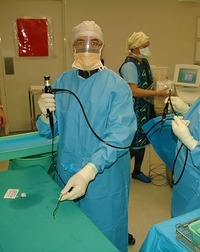
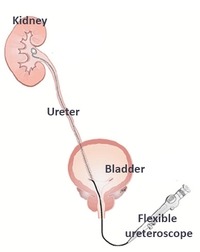
Endoscopic Procedures
These procedures require no incisions: they involve passing a tube with a small camera on the end, called a ureteroscope, through the ureter or kidney to the site of the stone.
To relieve obstruction and pain, a stent is placed in the ureter. Different instruments can then be inserted through the ureteroscope to allow fragmentation of the stone. This is called lithotripsy and there are two major technologies used to perform it:
- Laser lithotripsy, which utilises laser energy to fragment stones.
- LithoClast™ lithotripy, which allows either ultrasonic or pneumatic fragmentation.
After fragmentation, stone retrieval baskets can be passed via the ureteroscope to extract the stone fragments.
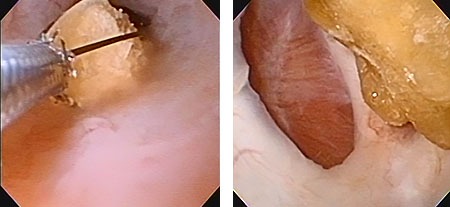
Endoscopic removal of a stone from the ureter.
Extracorporeal shockwave lithotripsy (ESWL)
ESWL is a procedure which fragments stones until they are small enough to pass by focusing shockwaves through an acoustic lens, most commonly using electromagnets to generate the shockwave.
The procedure is suitable for small stones, < 2 cm in diameter. It is entirely non-invasive, no tubes or incisions are made. It is is a day-only procedure performed under general anaesthetic.
Following the procedure, you may experience some modest bruising and blood in the urine. After fragmentation, stones can take up to six weeks to pass. In 25% of cases require more than one treatment.
Percutaneous nephrolithotomy
Some stones located in the kidneys are too complex to remove using ureteroscopy. Percutaneous nephrolithotomy is a procedure in which a small incision in the skin is made under X-ray guidance allowing the surgeon to see inside the kidney using a small tube called a nephroscope.
Like a ureteroscope, this tube contains a camera on the end allowing the stone to be visualised. It can then be fragmented and removed using lithotripsy.
This technique is useful for removal of very large kidney stones, > 2cm in length.
Open stone surgery.
Open stone surgery is very rare in the modern era – less than 1% of cases are treated with open surgery. Open surgery may be necessary for large stones that have been stuck in the ureter for and extended period or for complex kidney stones, called staghorn calculi, that are at risk of completely obstructing the flow from the kidneys and causing tissue damage.
Of course, prevention is the best cure for treating a kidney stone and this includes good hydration and avoidance of urinary tract infections. Lemon or lime juice may also be helpful as it contains citric acid which appears to prevent calcium from binding to other substances that form kidney stones.
Kidney stones frequently asked questions
Kidney stones statistics

About 30 – 50 per cent of people with a first kidney stone will get a second one within five years and then the risk reduces – Kidney Health Australia.

